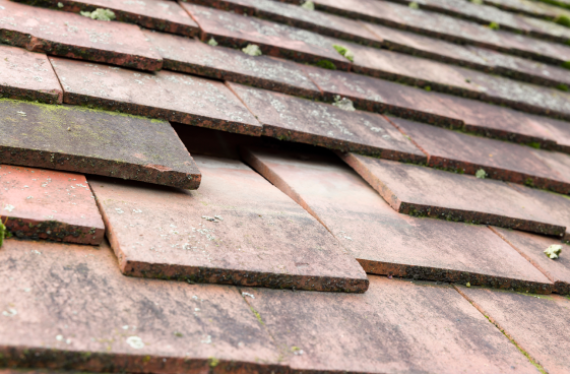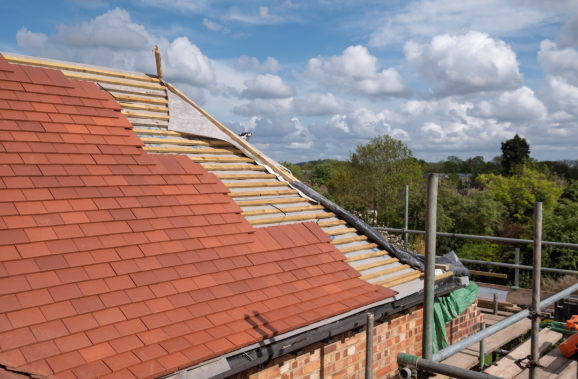Discovering water dripping from your ceiling or damp patches appearing after rainfall is never a pleasant experience. If you have a flat roof, you're already aware it requires more attention than a traditional pitched roof—but when leaks start appearing, it's crucial to act quickly.
Flat roofs are a popular choice across London for extensions, garages, and modern homes, particularly here in South West London. However, their low-pitch design makes them more vulnerable to water pooling and membrane damage. Left untreated, even a small leak can lead to structural damage, mould growth, and costly repairs.
In this comprehensive guide, we'll walk you through the most common causes of flat roof leaks, help you identify warning signs early, and explain when DIY fixes are appropriate versus when you need professional help. We'll also cover prevention strategies and typical repair costs in the UK for 2025.
Whether you're dealing with an emergency leak or looking to prevent future problems, this guide has everything you need to know.
Need expert help? Knights Roofing provides comprehensive flat roof leak detection and repair services throughout South West London. Contact us for a free assessment
Signs Your Flat Roof is Leaking

Catching a leak early can save you thousands in repair costs. Here are the key warning signs to watch for:
Interior Warning Signs:
Water stains on ceilings – Brown or yellow discolouration, often circular or irregular patches
Damp patches – Areas that feel wet to touch, especially after rain
Peeling paint or wallpaper – Moisture causes decorative finishes to lift and bubble
Musty odours – A damp, mouldy smell indicating trapped moisture. If you suspect mould growth, the NHS provides guidance on health risks associated with damp and mould
Visible dripping – In severe cases, water actively dripping from the ceiling
Exterior Warning Signs:
Ponding water – Puddles remaining on your roof 48+ hours after rainfall
Sagging areas – Sections of the roof that appear to dip or feel soft underfoot
Visible cracks or splits – Damage to the membrane surface
Blistering or bubbling – Raised areas indicating trapped moisture or air
Damaged or lifted flashing – Gaps where the roof meets walls or upstands
Important: Water doesn't always leak directly below the source. It can travel along roof structures before entering your home, making professional leak detection valuable for identifying the true origin point.
Common Causes of Flat Roof Leaks
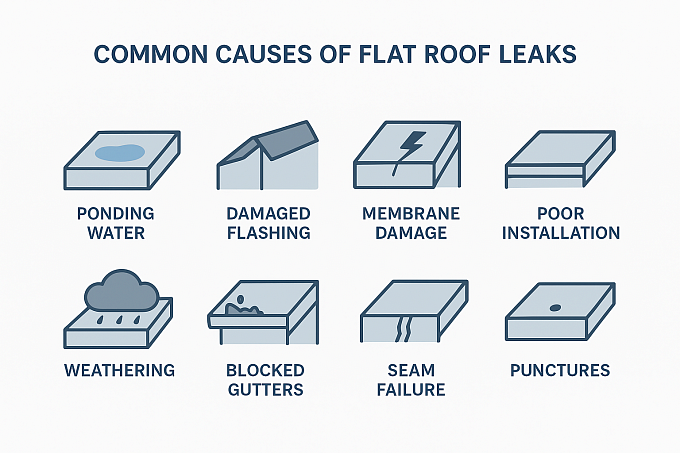
Understanding why flat roofs leak helps you prevent problems and identify issues early. Here are the eight most common causes we encounter at Knights Roofing:
1. Ponding Water (Standing Water)
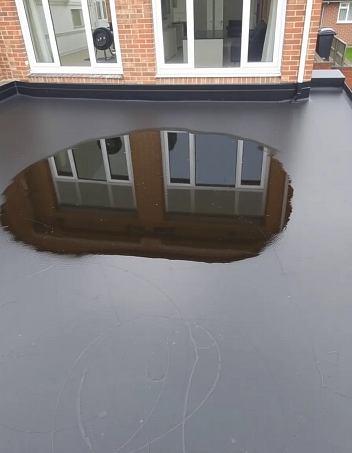
What it is: Water that remains on your flat roof for more than 48 hours after rainfall.
According to BS 6229:2018 (the British Standard for flat roof construction), roofs should have a minimum fall of 1:40 to promote drainage. When drainage is inadequate, water pools in low spots, placing constant stress on roofing materials. This standing water accelerates membrane degradation, can freeze in winter (expanding and causing cracks), and adds significant weight to the structure.
How to identify it: After dry weather for 2-3 days, inspect your roof. Any remaining puddles indicate poor drainage.
Severity: High – Ponding is one of the leading causes of premature flat roof failure.
2. Damaged or Deteriorating Flashing
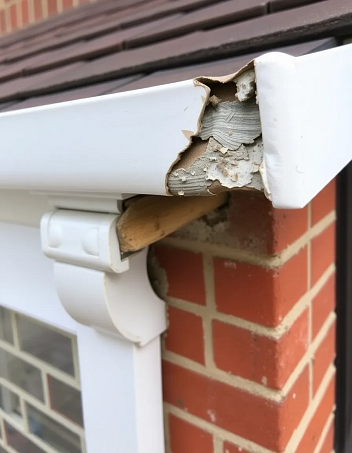
What it is: Lead or GRP flashing provides waterproof seals where your flat roof meets walls, chimneys, or other vertical surfaces.
Over time, lead flashing can crack due to thermal expansion and contraction. Temperature fluctuations cause the metal to expand when hot and contract when cold, eventually creating gaps. Poor installation or failed adhesives also contribute to flashing failure. The Lead Sheet Association provides comprehensive technical guidance on proper lead flashing installation to prevent these issues.
How to identify it: Look for visible gaps between the flashing and brickwork, peeling or lifted edges, or cracks in the lead itself.
Severity: High – Flashings are critical waterproofing components and common leak sources.
3. Membrane Damage (Blistering, Cracking, Splitting)
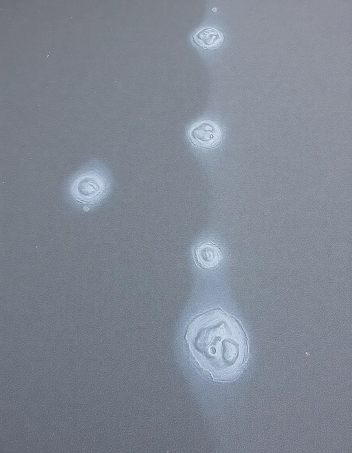
What it is: Your flat roof's waterproof membrane (felt, EPDM rubber, or GRP fibreglass) is its primary defence against water.
Blisters form when air or moisture becomes trapped between membrane layers during installation or when water penetrates beneath the surface. UV exposure, extreme temperatures, and age cause the membrane to become brittle and crack. Physical damage from foot traffic, falling debris, or tools also creates punctures. The Single Ply Roofing Association (SPRA) sets industry standards for membrane installation to minimize these risks.
How to identify it: Look for raised bubbles, visible cracks, tears in the surface, or areas where the membrane has pulled away from edges.
Severity: Medium to High – Small issues can often be patched, but widespread damage requires membrane replacement.
4. Poor Installation
What it is: Substandard workmanship is a leading cause of early flat roof failure.
Common installation errors include: insufficient membrane overlap at seams, inadequate heating of torch-on felt (causing poor adhesion), missing or incorrect insulation layers, improper falls creating drainage problems, and incompatible materials used together. Insurance companies report that poorly installed flat roofs typically develop leaks within 2 years.
This is why it's crucial to use NFRC (National Federation of Roofing Contractors) certified installers who follow proper installation standards and offer insurance-backed guarantees.
How to identify it: Multiple leak points, early failure of a newer roof, or visible installation defects like wrinkled membranes or poorly sealed seams.
Severity: Very High – Often requires complete roof replacement rather than repairs.
5. Age and General Weathering
What it is: All roofing materials have a finite lifespan.
Traditional felt roofs last 10-15 years, modern EPDM rubber 20-25 years, and GRP fibreglass 25-30 years. Constant exposure to UV rays, temperature extremes, wind, rain, and freeze-thaw cycles gradually breaks down even premium materials. According to the Met Office, the British weather—with its combination of heavy rain, occasional snow, and temperature fluctuations—is particularly harsh on flat roofing systems.
How to identify it: Your roof is approaching or exceeding its expected lifespan, showing signs of general degradation across the entire surface.
Severity: High – An aging roof needs replacement rather than repair.
6. Blocked Gutters and Drains
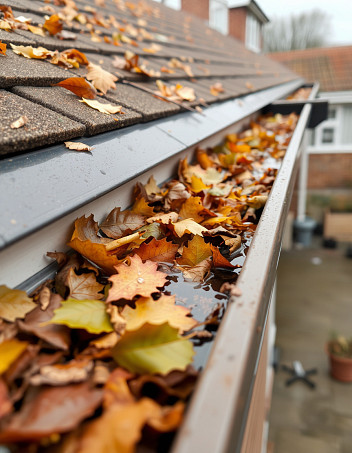
What it is: Flat roof drainage systems include outlets (drains), gutters, and downpipes that must remain clear.
Autumn leaves, moss, debris, and even bird nests can block drainage systems. When water cannot drain properly, it backs up onto the roof, causing ponding and potentially overflowing into the roofing structure itself. This leads to water ingress at the roof edges and accelerated membrane degradation.
How to identify it: Water overflowing from gutters during rain, visible debris buildup, or ponding water near drainage points.
Severity: Medium – Usually easy to fix but causes significant damage if neglected.
7. Failed Seams and Joints
What it is: Where sections of roofing material join together.
Most flat roofing membranes are installed in sections that overlap. These seams must be properly sealed—either with adhesive, heat welding, or mechanical fixings. Over time, poor installation, thermal movement, or material degradation causes seams to open. Oxidised bitumen adhesives used in older roofs (1980s-1990s) were particularly prone to failure as they couldn't accommodate thermal expansion.
How to identify it: Visible gaps or lifting at overlaps, water marks appearing in linear patterns on ceilings below.
Severity: Medium to High – Depends on extent; localized failures can be repaired, widespread issues need overhaul.
8. Punctures and Physical Damage
What it is: Holes or tears caused by impact or foot traffic.
Common causes include: ladders or scaffolding dragged across the roof, sharp objects dropped during maintenance work, foot traffic on unsuitable membranes (EPDM is vulnerable), or falling debris like broken tiles from adjacent pitched roofs. The Health and Safety Executive (HSE) provides guidance on safe working practices when accessing roofs to minimize accidental damage.
How to identify it: Visible holes, tears, or recent damage coinciding with maintenance work or storms.
Severity: Low to Medium – Individual punctures are usually easily patched if caught early.
How to Find the Source of a Flat Roof Leak
Locating the exact entry point of water is crucial but challenging. Unlike pitched roofs where water runs straight down, flat roofs allow water to travel horizontally between layers before finding a weak point to enter your property.
Interior Inspection
Start inside your property:
Note the leak location(s) – Mark every damp patch or drip point on your ceiling
Check your loft or roof void – If accessible, look for obvious damp patches, water trails, or saturated insulation
Measure from walls – Note distances from external walls to help locate the area when you inspect outside
Document timing – Does the leak worsen during heavy rain? Appear only after specific weather?
Exterior Inspection
Safety first: Only inspect your roof if you can do so safely. Use proper access equipment and never work alone. The HSE's guidance on working at height outlines essential safety requirements. If in doubt, call professionals.
For exterior inspection:
Wait for dry weather – Inspect at least 72 hours after rainfall for accurate assessment
Check the obvious areas first – Flashings, seams, around roof outlets and penetrations
Look for ponding – Note any areas where water collects
Feel for soft spots – Walk carefully and note any areas that feel spongy (indicates water damage beneath)
Use the evening method – After a warm day, inspect in early evening. Leaks often release stored heat and show as warm spots
Professional Detection Methods
If you cannot locate the leak, professionals use:
Electronic leak detection – High-voltage testing to pinpoint membrane breaches
Thermal imaging – Cameras detect temperature differences indicating moisture
Flood testing – Controlled water application to specific roof sections
Moisture meters – Measure water content in roof layers
DIY Flat Roof Leak Repairs
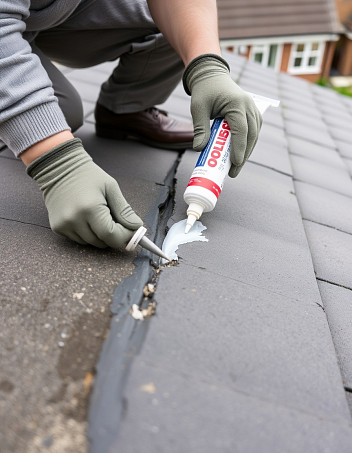
Small, localized leaks can sometimes be temporarily repaired by confident DIYers. However, it's crucial to understand that DIY fixes are almost always temporary and rarely address underlying issues.
When DIY Might Be Appropriate
The leak is very recent and limited to a small area (less than 30cm)
You've positively identified the source
The damage is a simple puncture or small crack
You're buying time until professional repair can be arranged
The roof structure itself isn't compromised
Materials and Tools Needed
Roofing cement or mastic sealant (bitumen-based for felt roofs)
Repair patches (matching your roof type)
Roofing primer
Putty knife or trowel
Wire brush
Heavy-duty scissors or knife
Safety equipment (non-slip footwear, harness if possible)
Step-by-Step DIY Repair Process
Clean the damaged area thoroughly – Remove all dirt, moss, loose material
Dry completely – Use old towels or wait for several dry days
Cut away loose or damaged material – Trim blisters and loose membrane
Apply primer – Follow manufacturer instructions
Apply roofing cement – Spread evenly across the damaged area
Place patch – For larger areas, use a reinforcing patch
Seal the edges – Apply additional cement around all edges
Apply second patch (if needed) – Larger than the first, creating overlapping layers
Critical Warnings
⚠️ DIY repairs are temporary fixes only. They may stop immediate water ingress but rarely solve the root cause.
⚠️ Working on roofs is dangerous. Falls from height are a leading cause of serious injury. Review the HSE's working at height regulations and don't attempt repairs in wet, windy, or icy conditions.
⚠️ Incorrect repairs can make problems worse – Trapping moisture beneath patches can accelerate rot and damage.
⚠️ Warranty concerns – DIY repairs typically void professional warranties or guarantees on your roof.
If you're at all unsure, or if your DIY repair doesn't solve the problem, call professionals immediately to prevent further damage.
When to Call Professional Roofers
Certain situations absolutely require professional expertise:
Red Flags Requiring Professional Help
Multiple leak points – Indicates widespread problems rather than isolated damage
Structural concerns – Soft, spongy areas suggesting deck damage beneath the membrane
Extensive ponding – Drainage redesign needed to comply with BS 6229:2018
Large damaged areas – More than 1-2 square meters affected
Age-related failure – Roof approaching or past its expected lifespan
Previous DIY repairs failed – The problem is more complex than initially thought
Wet insulation – Requires removal and replacement to prevent mold
Cannot locate the source – Professional detection equipment needed
Safety concerns – Steep areas, difficult access, or height anxiety
Risks of Delaying Professional Repair
Postponing professional intervention when needed can lead to:
Structural timber rot – Joists and decking can deteriorate rapidly once wet
Mold and health issues – Damp environments promote mold growth that can affect health, particularly for vulnerable individuals
Increased repair costs – A £500 repair can become a £5,000 replacement
Internal damage – Ceilings, walls, electrics, insulation, and possessions
Insurance complications – Delays in addressing known problems may affect claims. The Association of British Insurers (ABI) recommends reporting issues promptly
Need expert help? Knights Roofing provides comprehensive flat roof leak detection and repair services throughout South West London. Contact us for a free assessment.
Professional Flat Roof Repair Options
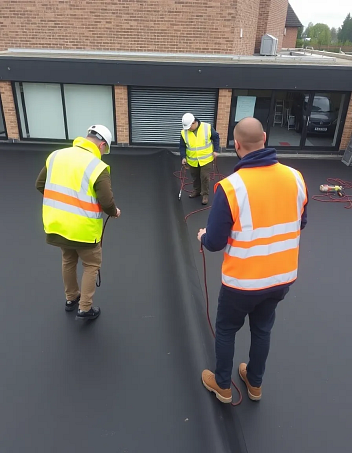
Professional roofers can offer several solutions depending on your roof's condition:
- Patch Repairs
Best for: Localized damage, recent issues, otherwise sound roofs
Professionals cut away damaged sections, prepare the area properly, apply new membrane patches with proper overlaps and sealing, and ensure compatibility with existing materials. All work should meet NFRC standards for quality assurance.
UK Cost Guide (2025): £200 - £600 depending on size and access
- Roof Overlay Systems
Best for: Aging roofs with surface deterioration but sound structure
A new roofing membrane is installed over the existing roof (after assessment and preparation). This extends roof life by 15-25 years, improves insulation to meet current Building Regulations Part L (conservation of fuel and power), and is more cost-effective than full replacement.
UK Cost Guide (2025): £45 - £90 per m² including materials and labour
- Complete Roof Replacement
Best for: Old roofs, extensive damage, structural issues
Everything is stripped back to the deck, damaged timber is replaced, new insulation installed, vapor control layer added, and new membrane system installed (EPDM, GRP, or felt).
Modern replacements include proper falls for drainage and meet current building regulations for both insulation and fire safety.
UK Cost Guide (2025):
Small garage (15m²): £1,200 - £2,500
Medium extension (25m²): £2,000 - £4,000
Large flat roof (50m²+): £4,000 - £8,000+
Prices vary based on:
Chosen material (EPDM, GRP, or felt)
Access difficulty
Structural repairs needed
Insulation requirements to meet Building Regulations
Location (London typically 15-20% higher than national average)
Preventing Future Flat Roof Leaks
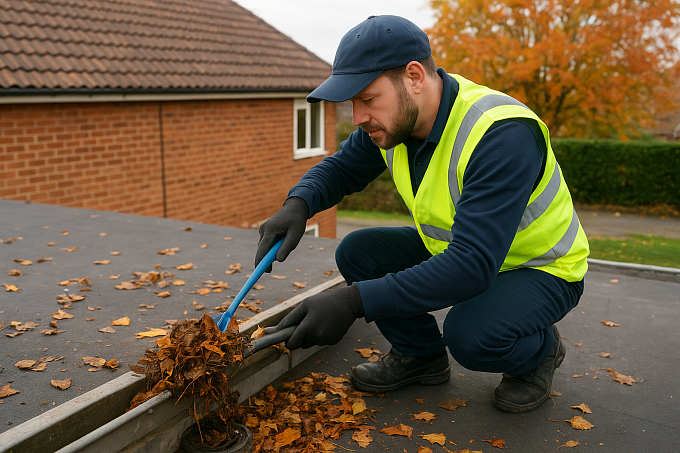
Prevention is always more cost-effective than cure. Here's how to maximize your flat roof's lifespan:
Regular Inspection Schedule
Every 6 months – Visual inspection from ground level after clear weather
Annually – Full professional inspection and maintenance check
After severe weather – Check following storms, heavy snow, or prolonged rainfall. The Met Office provides advance warnings for severe weather
Autumn – Clear gutters and drains before winter rainfall
Maintenance Best Practices
Keep it clean:
Remove leaves, moss, and debris regularly
Clear gutters and drains promptly
Trim overhanging tree branches
Address minor issues immediately:
Fix small cracks before they spread
Replace damaged flashings promptly
Don't let problems "wait until next year"
Improve drainage:
Ensure minimum 1:40 fall throughout (per BS 6229:2018)
Add extra drainage outlets if needed
Consider tapered insulation systems for problem areas
Protect the surface:
Limit foot traffic
Use walkway boards when accessing for maintenance
Apply UV-protective coatings every 5-7 years
Professional touch:
Schedule annual professional inspections by NFRC members
Keep records of all work done
Maintain warranties with proper documentation
Material Choices for Longevity
When replacement time comes, consider:
EPDM rubber – Excellent durability, 20-25 year lifespan, good value. Look for BBA certified products
GRP fibreglass – Strongest option, 25-30+ years, best for foot traffic areas
High-performance felt – Budget-friendly, 15-20 years with quality products
Always choose certified installers who offer insurance-backed guarantees through schemes like TrustMark or CompetentRoofer.
Flat Roof Leak Repair Costs in the UK (2025)
Understanding typical costs helps you budget and avoid overcharging. According to Which?, here are realistic UK price ranges:
DIY Repair Costs
Roofing cement (2.5L): £15 - £30
Repair patches (per m²): £8 - £20
Complete DIY kit: £40 - £80
Total for small repair: £50 - £100
Professional Repair Costs
Minor patch repairs:
Small area (less than 1m²): £200 - £400
Medium area (1-3m²): £400 - £700
Large area (3-5m²): £700 - £1,200
Flashing replacement:
Per linear meter: £80 - £150
Chimney flashing complete: £300 - £600
Roof coating/sealing:
Professional liquid coating: £30 - £60 per m²
Overlay systems:
EPDM overlay: £45 - £70 per m²
GRP overlay: £60 - £90 per m²
Full Replacement Costs
By roof size (including materials, labour, VAT):
Small flat roof (10-20m²):
Felt system: £900 - £1,800
EPDM rubber: £1,200 - £2,500
GRP fibreglass: £1,500 - £3,000
Medium flat roof (20-40m²):
Felt system: £1,800 - £3,500
EPDM rubber: £2,400 - £5,000
GRP fibreglass: £3,000 - £6,500
Large flat roof (40-60m²):
Felt system: £3,500 - £6,000
EPDM rubber: £5,000 - £8,500
GRP fibreglass: £6,500 - £11,000
Factors Affecting Costs
Location: London commands 15-20% premium over national averages; some South West London areas may have additional access challenges
Access: Scaffolding requirements add £400-£1,200; difficult access increases labour time
Structural issues: Rotten deck replacement adds £25-£45 per m²; joist repairs extra
Building regulations: Insulation upgrades to meet current Part L standards add £15-£30 per m²
Waste removal: Skip hire £150-£300 depending on size
Always obtain at least 3 detailed written quotes specifying materials, labor, guarantees, and timescales.
Frequently Asked Questions
How long does it take to repair a flat roof leak?
Simple patch repairs can be completed in 2-4 hours. Larger repairs or overlay systems typically take 1-3 days. Complete roof replacements on an average domestic property take 3-7 days depending on size, access, and weather conditions.
Can I repair a flat roof in winter?
Professional repairs can be undertaken in winter provided temperatures are above 5°C and the roof surface is completely dry. Torch-on felt and EPDM adhesives require specific temperature ranges to cure properly. Emergency temporary repairs can be done in almost any weather to prevent further damage until proper repairs are possible. Check the Met Office forecast before scheduling work.
Will my home insurance cover flat roof leak repairs?
Most home insurance policies cover sudden, unexpected damage (like storm damage or burst pipes affecting the roof). However, damage from wear and tear, poor maintenance, or gradual deterioration is typically excluded. If the leak has caused internal damage, your contents insurance may cover belongings and interior repairs. The Money Advice Service offers guidance on understanding your home insurance policy. Always check your specific policy and report leaks promptly.
How long should a flat roof last?
Lifespan depends on the material:
Traditional felt: 10-15 years
High-performance felt: 15-20 years
EPDM rubber: 20-25 years
GRP fibreglass: 25-30+ years
Proper installation by NFRC certified contractors, regular maintenance, and good drainage significantly extend these estimates. Neglected roofs may fail prematurely, while well-maintained roofs often exceed expected lifespans.
Can you put a new flat roof over an old one?
Yes, overlay systems are common and cost-effective when the existing deck is sound. However, this isn't always suitable. A professional survey must confirm: the existing deck is structurally sound and dry, there's no extensive rot or damage, building regulations allow the added weight, and ventilation won't be compromised. Overlays typically add 15-20 years to roof life at 40-60% of the cost of complete replacement. Work must comply with Building Regulations.
What's the best flat roof material?
The "best" material depends on your priorities:
Best value: EPDM rubber (good performance-to-cost ratio)
Longest lasting: GRP fibreglass (30+ years, excellent durability)
Budget option: High-performance felt (if properly installed and maintained)
Best for foot traffic: GRP fibreglass (can be walked on regularly)
The Single Ply Roofing Association provides detailed information on different membrane types. Your roofer should recommend based on your specific situation, budget, and requirements.
How do you stop a flat roof from leaking temporarily?
For emergency temporary fixes: clear any standing water, dry the area as much as possible, apply thick roofing mastic or emergency repair tape over the leak, weight down with boards if needed during bad weather, and place buckets inside to catch drips. Then arrange professional inspection as soon as possible. Remember these are short-term measures only.
Do flat roofs always leak?
No. This is a common myth. Well-designed, properly installed (following BS 6229:2018), and regularly maintained modern flat roofs are highly reliable and rarely leak. Problems typically arise from poor installation, inadequate drainage, or lack of maintenance. Modern materials like EPDM and GRP have excellent performance records when installed by certified professionals.
Can I convert my flat roof to a pitched roof?
Yes, but it's a major structural project requiring planning permission and building regulations approval. Costs typically range from £3,000-£10,000+ depending on size and complexity. This is usually only worthwhile if you're also extending or significantly renovating. For most domestic situations, a modern flat roof replacement is more cost-effective and perfectly adequate.
How often should I inspect my flat roof?
Professional inspection annually by an NFRC member, plus your own visual checks every 6 months and after severe weather. Regular inspection catches small problems before they become expensive repairs. Most professional guarantees require annual inspections to remain valid.
Final Thoughts: Protecting Your Investment
A leaking flat roof doesn't have to mean disaster, but it does demand prompt attention. Whether you're dealing with a new leak or looking to prevent future problems, the key is understanding your roof's condition and acting decisively.
Remember the essentials:
Inspect regularly and catch problems early
Address minor issues before they escalate
Know when DIY is appropriate and when professionals are needed
Invest in quality materials and certified installation
Maintain proper drainage to prevent ponding
Keep records of all work and inspections
A well-maintained flat roof should provide decades of reliable service. But when leaks do occur—and eventually they will—having the right expertise makes all the difference between a quick fix and an expensive emergency.
Get Expert Flat Roof Repair in South West London
Don't let a small leak become a major problem. Knights Roofing has been serving homeowners and businesses across London for over 20 years, providing expert flat roof inspection, repair, and replacement services.
Why Choose Knights Roofing?
NFRC Certified & Fully Insured – Qualified roofers with comprehensive insurance
Free Inspections – No-obligation assessment and detailed quote
All Materials – EPDM, GRP, felt—we work with all systems
Guaranteed Work – Insurance-backed guarantees on all installations
Trusted Since 2004 – Over 20 years of excellence in London roofing
Transparent Pricing – Detailed quotes with no hidden costs
Emergency Response – Same-day callouts for urgent leaks
Our Service Area
We provide flat roof repair services throughout South West London, including:
Battersea • Wandsworth • Clapham • Putney • Wimbledon • Richmond • Barnes • Fulham • Chelsea • Kensington • Hammersmith • Tooting • Balham • Streatham • and surrounding areas
Contact us today for a free, no-obligation assessment of your flat roof.
Whether you need emergency leak repair, routine maintenance, or a complete roof replacement, our experienced team is ready to help.
Related Services:
Flat Roof Repair & Installation
Pitched Roofing Repairs
Emergency Roofing Services
Gutter Cleaning & Repairs
Further Reading:
EPDM Rubber Roofing: Complete Guide
How to Choose the Right Flat Roof Material
Flat Roof Maintenance: Seasonal Checklist



